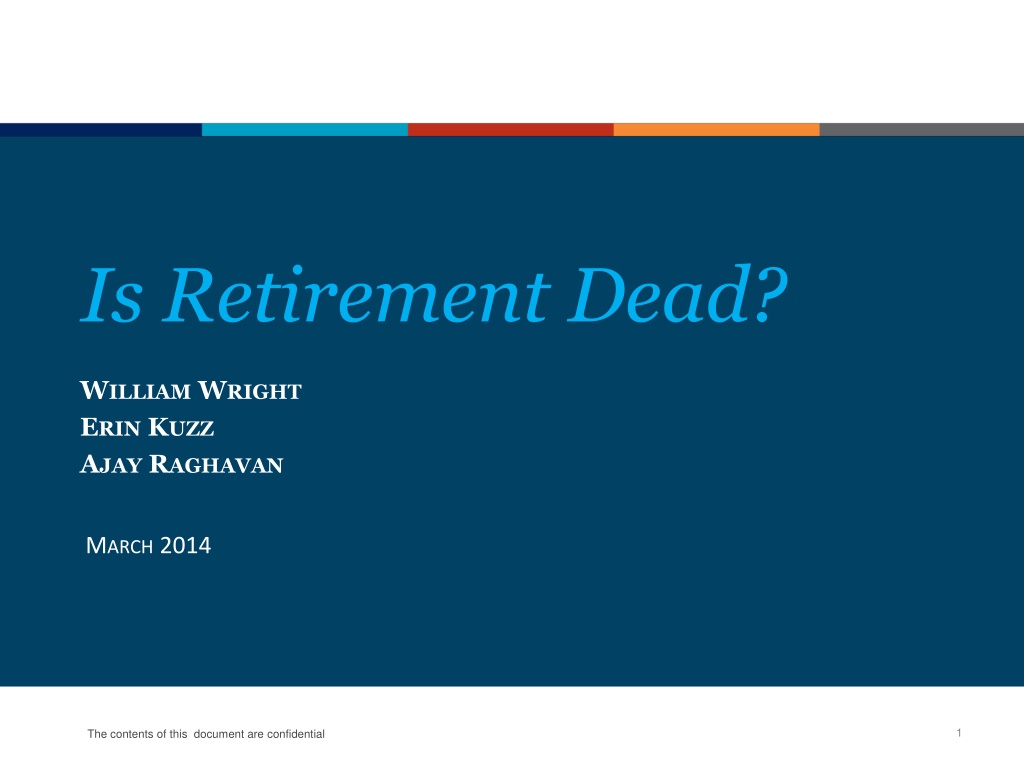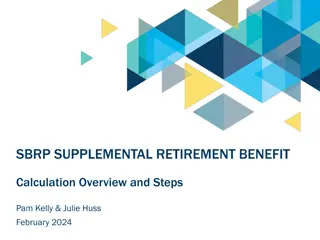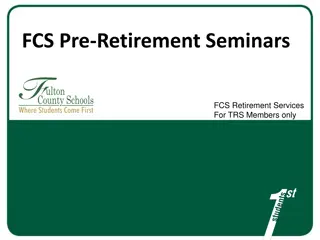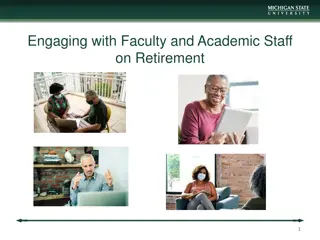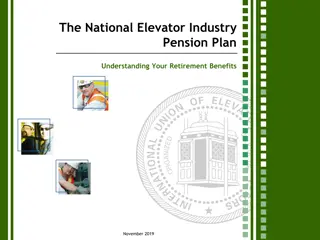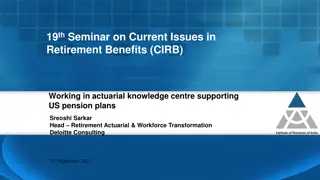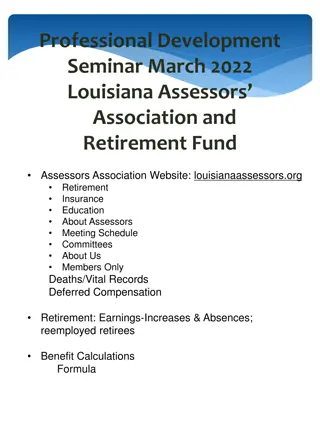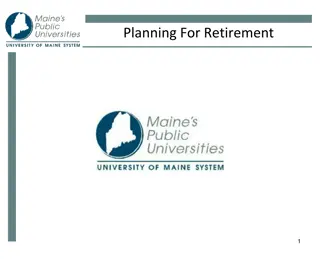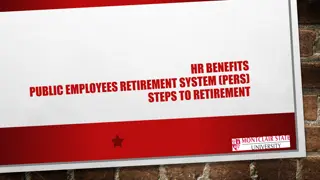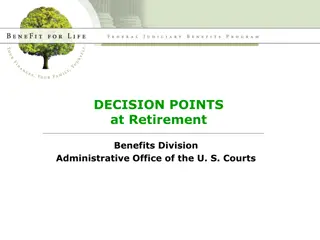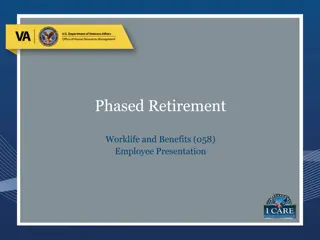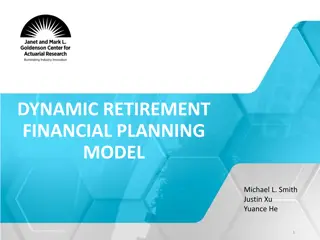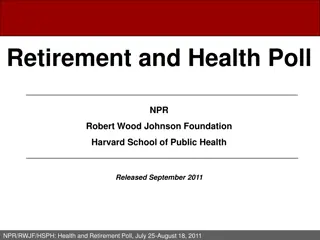The Changing Landscape of Retirement: Trends and Challenges
The document "Is Retirement Dead?" delves into the evolving concept of retirement, highlighting significant shifts in retirement planning and policies across various countries. It explores statistics showing a decline in the number of American workers planning to retire early, challenges faced by older adults in financial stability, differences in retirement practices globally, and projections for the aging population in countries like China. Additionally, it provides insights into retirement ages in different countries, emphasizing the varying approaches to retirement regulations. The confidential nature of the document underscores the sensitivity and importance of the discussed information.
Download Presentation

Please find below an Image/Link to download the presentation.
The content on the website is provided AS IS for your information and personal use only. It may not be sold, licensed, or shared on other websites without obtaining consent from the author. Download presentation by click this link. If you encounter any issues during the download, it is possible that the publisher has removed the file from their server.
E N D
Presentation Transcript
Is Retirement Dead? WILLIAM WRIGHT ERIN KUZZ AJAY RAGHAVAN MARCH 2014 The contents of this document are confidential 1
Snapshot The contents of this document are confidential Page 2
Quick Facts The contents of this document are confidential 3
Quick Facts In 1991, about 50% of all American workers planned to retire before they reached the age of 65. Today, that number has plunged to less than 25%. In the 1980 s there were 5 Canadians actively in the workforce for every 1 worker on CPP (Canada Pension Plan); by 2013 those numbers will be 2:1. Between 1991 and 2007, the number of Americans between the ages of 65 and 74 that filed for bankruptcy increased by almost 200%. Despite the fact that women have a higher life expectancy than men, the retirement age for women is lower than men in many countries. The contents of this document are confidential Page 4
Quick Facts In countries like France and Italy only 1% of the population above the age of 65 are employed. This number is as high as 10% in the UK and 20% in USA. In countries like Australia, USA and now Canada, compulsory or mandatory retirement on attaining a certain age is generally unlawful (subject to exceptions for some sectors such as the military or where BFOR exists (fire suppression, pilots, etc.). In the Roman Catholic Church, Pope Paul VI introduced a mandatory retirement age of 70 for priests and 75 for bishops and archbishops; there is no mandatory retirement age for the pope as he holds that position for life. The contents of this document are confidential Page 5
World Demography at a glance The contents of this document are confidential 6
World Demography at a glance USA JAPAN UK INDIA CHINA CANADA Old (65+)13% 23% 17% 5% 10% 15% Young (- 14) 20% 13% 18% 31% 17% 16% A massive 73% of China s population is the 15-64 age bracket, which means that in a couple of decades China is likely to see a giant bulge in the percentage of its aged population. The contents of this document are confidential Page 7
Retirement Age The contents of this document are confidential 8
Retirement Age S.NO. COUNTRY RETIREMENT AGE 45 45 59 59 60 60 60.5 60.5 63 63 65 65 65 65 67 67 65 65 (to be increased to 67) 1 Turkey 2 Italy 3 Korea 4 France 5 World Average 6 Japan 7 United Kingdom 8 Norway 9 Germany Apart from in rare cases such as Sweden and Ireland, the average retirement age across countries has been rising over the years. The contents of this document are confidential Page 9
Public v Private Sector The contents of this document are confidential 10
Process PUBLIC SECTOR In the US, public sector employees have fixed retirement ages that are quite low: e.g. local police (55-60), fire fighters (55-60), law enforcement and correction officers (57), air traffic controllers (56) etc. Retirement age for employees in Indian Public Sector Undertakings is set at 60, with a proposal to increase it to 62. Due to attractive pension benefits for the public sector in Canada even on early retirement, Canada s public sector employees retire earlier than anywhere else in the world. Studies from the late 2000s showed that while the general Canadian labour force retired at age 62 on a average, the public sector retired at 58. The contents of this document are confidential Page 11
Process PRIVATE SECTOR Anti age discrimination laws in some countries prohibit private employers from fixing a retirement age in countries like the US. The Bar Council of Delhi proposed that, in order to maintain the high standards and efficiency of lawyers there must be regulation on their retirement age by (i) preventing persons who have crossed 45 years of age from enrolling; (ii) setting the retirement age at 70. In Canada, whether law firm partners can be forced to retire in midst of litigation (are they employees or not?) The contents of this document are confidential Page 12
Some Pertinent Questions The contents of this document are confidential 13
Some Pertinent Questions 1. What are the goals of retirement? Leisure, basic living expenses, rewards. 2. Why do people retire? Why Don t they retire? 3. Is retirement savings an individual, employer or government function? Or a combination of all three? The Australian Model: The Age Pension Their version of Social Security and it pays up to about $28,000 a year to people roughly 65 and older (scheduled to rise to 67 in 2023). Australians don t pay into the system; the money comes from the government s general revenues. Means test only 56% of ppl collect full amount. Mandatory retirement saving program known as The Super (short for Superannuation Guarantee) Employers are required to contribute into tax-advantaged retirement plans 9.25% of earnings for virtually all employees age 18 to 70. That percentage will gradually rise to 12% by 2020. Employees choose where to invest the money. No loans or early withdrawals permitted. As a resulte, wage increases average 0.5-1% Voluntary savings average 10% The contents of this document are confidential Page 14
Some Pertinent Questions 4. What are the solutions to funding issues? - Raise contribution levels - Lower Benefits - Raise Retirement Age 5. Changing to Defined Contribution: Issues of a two class system for decades 6. Is it better from a societal standpoint for people to retire or is it better that they don t? - If so, how do we help them do it gracefully ? 7. From a purely legal perspective, is it better for people to retire or is it better that they don t? 8. What can companies do to assist? What should they do? Do they want to/care? The contents of this document are confidential Page 15
